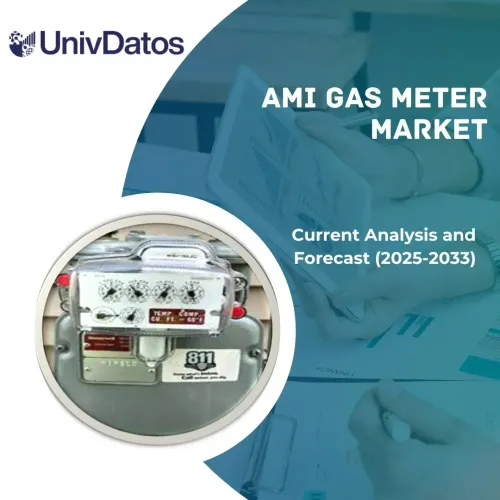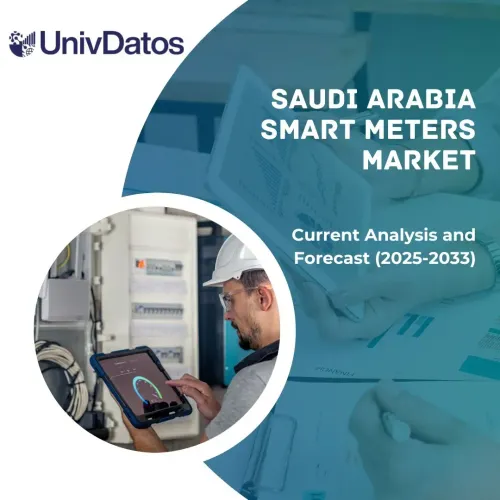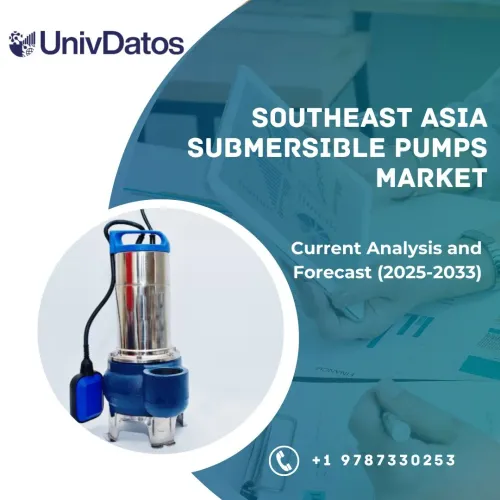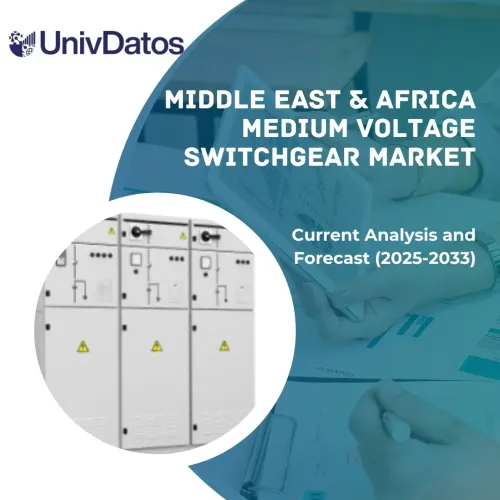- Home
- About Us
- Industry
- Services
- Reading
- Contact Us
Small Hydropower Market: Current Analysis and Forecast (2024-2032)
Emphasis on Type (Micro and Mini Hydropower); Capacity (Up To 1 MW and 1 – 10 MW); Component (Electric Infrastructure, Electromechanical Equipment, Civil Works, and Others); Region/Country.
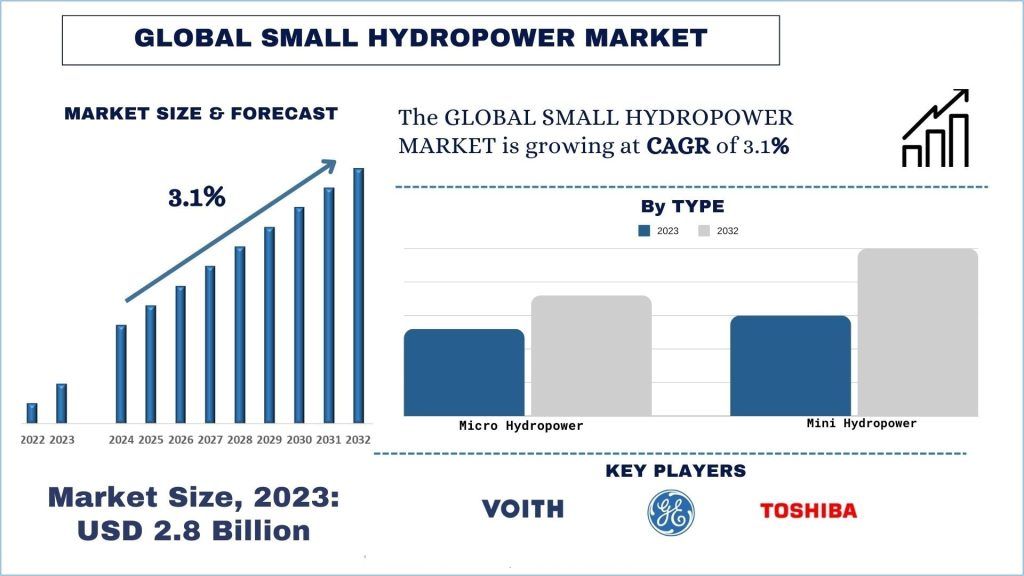
Small Hydropower Market Size & Forecast
The Small Hydropower Market was valued at USD 2.8 Billion and is expected to grow at a strong CAGR of around 3.1% during the forecast period (2024-2032) owing to rising demand for renewable energy.
Small Hydropower Market Analysis
The Small Hydropower Market, encompassing hydroelectric power plants with capacities up to 10 MW, is an essential segment of the global renewable energy landscape. Small hydropower (SHP) systems harness the energy from flowing or falling water to generate electricity, offering a clean and sustainable alternative to fossil fuels. Small hydropower systems offer numerous benefits, including providing clean and renewable energy, reducing greenhouse gas emissions, and contributing to rural electrification. They are particularly effective in remote and rural areas where access to the main power grid is limited. SHP projects can support local communities by providing reliable electricity, enhancing living standards, and fostering economic development.
The global small hydropower market is driven by the increasing demand for renewable energy, supportive government policies and incentives, and the need for sustainable power generation solutions. Regions with abundant water resources, such as Europe, Asia-Pacific, and North America, present significant opportunities for SHP development. Government initiatives aimed at reducing carbon emissions and promoting renewable energy further boost the market. Advancements in turbine technology, digital monitoring, and control systems have significantly improved the efficiency and reliability of SHP projects. Innovations such as fish-friendly turbines and low-impact designs help minimize environmental disruptions, making SHP projects more sustainable and acceptable to local communities.
Despite its benefits, the SHP market faces high initial capital costs, regulatory hurdles, and potential environmental impacts. Navigating complex regulatory frameworks and ensuring the ecological sustainability of projects require careful planning and investment. Addressing these challenges is crucial for the continued growth and acceptance of SHP projects. However, the future of the small hydropower market looks promising, with ongoing investments in technology and infrastructure. The integration of SHP with other renewable energy sources, such as solar and wind, can create hybrid systems that offer greater reliability and efficiency. As global efforts to combat climate change intensify, SHP will play an increasingly vital role in achieving renewable energy targets and promoting sustainable development.
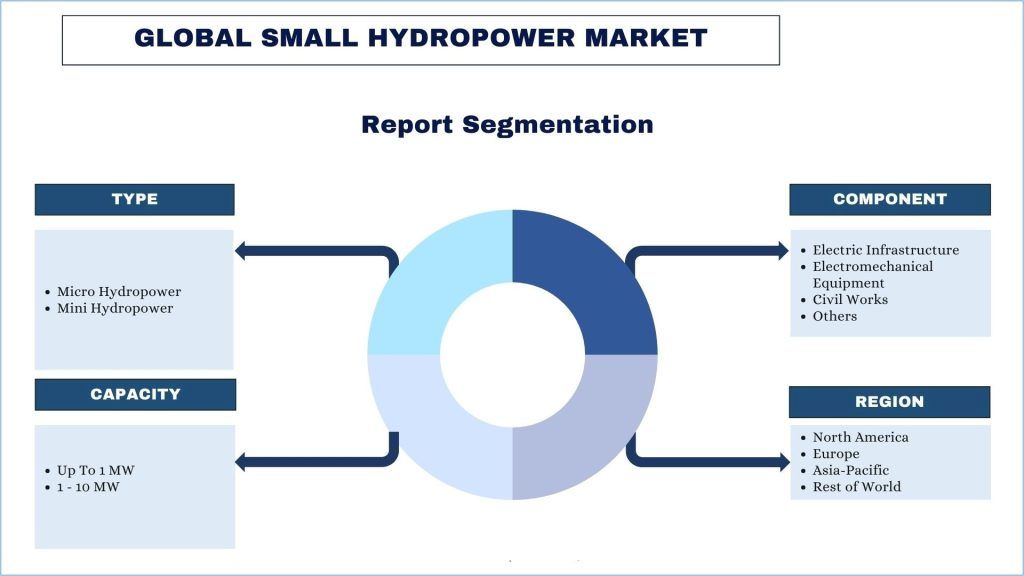
Small Hydropower Market Trends
This section discusses the key market trends that are influencing the various segments of Small Hydropower as identified by our team of research experts.
Government Policies Supporting the Small Hydropower Industry
Government policies and incentives play a crucial role in promoting the development and expansion of the small hydropower industry. These policies are designed to reduce financial barriers, streamline regulatory processes, and encourage investment in renewable energy projects. Following are some key policies of government support for small hydropower:
1. Subsidies and Financial Incentives: Many governments offer subsidies and financial incentives to lower the initial capital costs associated with small hydropower projects. These incentives can include direct grants, low-interest loans, and tax credits. For example, the United States provides federal tax incentives through the Renewable Electricity Production Tax Credit (PTC) and the Investment Tax Credit (ITC), which help reduce the financial burden on developers and investors.
2. Feed-in Tariffs (FiTs): Feed-in tariffs are policies that guarantee a fixed price for the electricity generated from renewable sources, including small hydropower. This ensures a stable revenue stream for project developers. For instance, Germany has implemented FiTs that provide long-term contracts and attractive rates for electricity generated from small hydropower plants, incentivizing their development.
3. Renewable Portfolio Standards (RPS): Renewable Portfolio Standards mandate that a certain percentage of electricity must come from renewable sources. These standards drive the demand for renewable energy, including small hydropower. In India, various states have set RPS targets to increase the share of renewable energy in their energy mix, promoting the growth of small hydropower projects.
4. Simplified Permitting and Regulatory Processes: Streamlined permitting and regulatory processes reduce the administrative burden and time required to develop small hydropower projects. For example, the European Union has implemented policies to simplify the approval process for small hydropower projects, making it easier for developers to navigate regulatory requirements and commence construction.
5. Research and Development (R&D) Support: Governments support research and development to advance small hydropower technologies. Funding for R&D helps improve the efficiency, reliability, and environmental sustainability of small hydropower systems. The U.S. Department of Energy (DOE) funds R&D initiatives aimed at developing innovative hydropower technologies and improving existing infrastructure.
6. Rural Electrification Programs: Programs aimed at rural electrification often include provisions for developing small hydropower projects. These programs aim to provide reliable electricity to remote and underserved areas. In countries like Nepal and Bhutan, rural electrification initiatives have successfully utilized small hydropower to bring electricity to remote communities, improving living standards and supporting local development.
7. Environmental and Social Impact Mitigation: Governments also implement policies to mitigate the environmental and social impacts of small hydropower projects. These policies ensure that projects are developed sustainably, with minimal ecological disruption. For example, regulations in Norway require environmental impact assessments and the implementation of measures to protect local ecosystems and communities.

APAC is Expected to Grow with Significant CAGR During Forecast Period
APAC registered the highest market share in the Small Hydropower market and is expected to witness an influential CAGR in the forecasted period. The small hydropower (SHP) market in the Asia-Pacific (APAC) region is experiencing robust growth due to several key drivers. Abundant water resources across the region, with extensive river systems and numerous water bodies, provide a natural advantage for the development of small hydropower projects. This geographical benefit is particularly significant in rural and remote areas where other forms of energy may be less accessible. Government policies and incentives play a crucial role in promoting SHP in the APAC region. Various countries have implemented supportive measures, including subsidies, tax incentives, grants, and streamlined regulatory processes. These initiatives reduce financial and administrative barriers for developers, encouraging investment in small hydropower. For instance, China’s Renewable Energy Law and India’s National Hydropower Policy are pivotal in supporting the growth of SHP projects.
Small Hydropower Market Industry Overview
The Small Hydropower Market is competitive and fragmented, with the presence of several global and international market players. The key players are adopting different growth strategies to enhance their market presence, such as partnerships, agreements, collaborations, new product launches, geographical expansions, and mergers and acquisitions. Some of the major players operating in the market are Voith GmbH & Co. KGaA, ANDRITZ AG, GE Renewable Energy, Siemens AG, Toshiba Energy Systems & Solutions Corporation, BHEL (Bharat Heavy Electricals Limited), Gilkes Hydro, Mavel, a.s., CKD Blansko Holding, a.s., and Harbin Electric Machinery Company Limited.
Small Hydropower Market News
In February 2024, the Nepal Electricity Authority (NEA) decided to open power purchase agreements (PPA) with small hydropower companies tasked with producing up to 10 megawatts of electricity. The NEA has welcomed all small hydropower projects built under the modalities of run-of-the-river (RoR) and semi-storage projects.
In October 2021, Voith Group strengthened its core hydropower business and acquired Siemens Energy’s stake in Voith Hydro. The technology group and the long-term partner Siemens Energy agreed on a buy-out of the remaining 35 percent stake in the former Voith Siemens Hydro Power Generation GmbH & Co. KG.
Small Hydropower Report Coverage
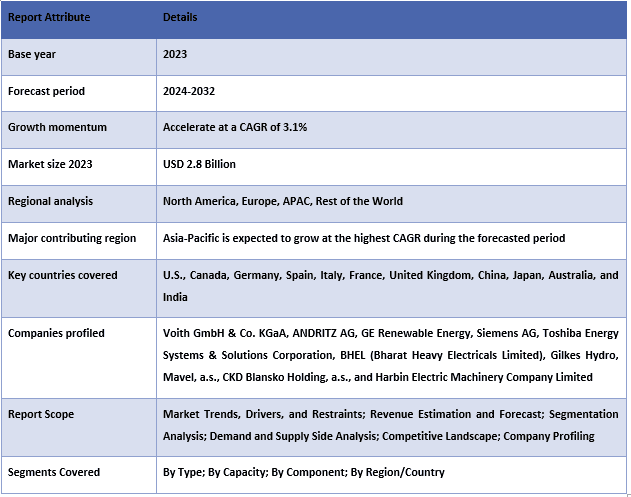
Reasons to buy this report:
- The study includes market sizing and forecasting analysis validated by authenticated key industry experts.
- The report presents a quick review of overall industry performance at one glance.
- The report covers an in-depth analysis of prominent industry peers with a primary focus on key business financials, product portfolios, expansion strategies, and recent developments.
- Detailed examination of drivers, restraints, key trends, and opportunities prevailing in the industry.
- The study comprehensively covers the market across different segments.
- Deep dive regional level analysis of the industry.
Customization Options:
The Global Small Hydropower Market can further be customized as per the requirement or any other market segment. Besides this, UMI understands that you may have your own business needs, hence feel free to connect with us to get a report that completely suits your requirements.
Table of Content
Research Methodology for the Small Hydropower Market Analysis (2024-2032)
Analyzing the historical market, estimating the current market, and forecasting the future market of global Small Hydropower were the three major steps undertaken to create and explore the adoption of Small Hydropower in major regions globally. Exhaustive secondary research was conducted to collect the historical market numbers and estimate the current market size. Secondly, numerous findings and assumptions were taken into consideration to validate these insights. Moreover, exhaustive primary interviews were also conducted with industry experts across the value chain of the global Small Hydropower. Post assumption and validation of market numbers through primary interviews, we employed a top-down/bottom-up approach to forecasting the complete market size. Thereafter, market breakdown and data triangulation methods were adopted to estimate and analyze the market size of segments and sub-segments of the industry. Detailed methodology is explained below:
Analysis of Historical Market Size
Step 1: In-Depth Study of Secondary Sources:
A detailed secondary study was conducted to obtain the historical market size of the Small Hydropower through company internal sources such as annual reports & financial statements, performance presentations, press releases, etc., and external sources including journals, news & articles, government publications, competitor publications, sector reports, third-party database, and other credible publications.
Step 2: Market Segmentation:
After obtaining the historical market size of Small Hydropower, we conducted a detailed secondary analysis to gather historical market insights and share for different segments and sub-segments for major regions. Major segments are included in the report as Type, Capacity, and Component. Further country-level analyses were conducted to evaluate the overall adoption of testing models in that region.
Step 3: Factor Analysis:
After acquiring the historical market size of different segments and sub-segments, we conducted a detailed factor analysis to estimate the current market size of the Small Hydropower. Further, we conducted factor analysis using dependent and independent variables such as Type, Capacity, and Component of the Small Hydropower. A thorough analysis was conducted of demand and supply-side scenarios considering top partnerships, mergers and acquisitions, business expansion, and product launches in the Small Hydropower sector across the globe.
Current Market Size Estimate & Forecast
Current Market Sizing: Based on actionable insights from the above 3 steps, we arrived at the current market size, key players in the global Small Hydropower, and market shares of the segments. All the required percentage shares split, and market breakdowns were determined using the above-mentioned secondary approach and were verified through primary interviews.
Estimation & Forecasting: For market estimation and forecast, weights were assigned to different factors including drivers & trends, restraints, and opportunities available for the stakeholders. After analyzing these factors, relevant forecasting techniques i.e., the top-down/bottom-up approach were applied to arrive at the market forecast for 2032 for different segments and sub-segments across the major markets globally. The research methodology adopted to estimate the market size encompasses:
- The industry’s market size, in terms of revenue (USD) and the adoption rate of the Small Hydropower across the major markets domestically
- All percentage shares, splits, and breakdowns of market segments and sub-segments
- Key players in the global Small Hydropower in terms of products offered. Also, the growth strategies adopted by these players to compete in the fast-growing market
Market Size and Share Validation
Primary Research: In-depth interviews were conducted with the Key Opinion Leaders (KOLs) including Top Level Executives (CXO/VPs, Sales Head, Marketing Head, Operational Head, Regional Head, Country Head, etc.) across major regions. Primary research findings were then summarized, and statistical analysis was performed to prove the stated hypothesis. Inputs from primary research were consolidated with secondary findings, hence turning information into actionable insights.
Split of Primary Participants in Different Regions

Market Engineering
The data triangulation technique was employed to complete the overall market estimation and to arrive at precise statistical numbers for each segment and sub-segment of the global Small Hydropower. Data was split into several segments & sub-segments post studying various parameters and trends in the areas of Type, Capacity, and Component in the global Small Hydropower.
The main objective of the Global Small Hydropower Study
The current & future market trends of the global Small Hydropower were pinpointed in the study. Investors can gain strategic insights to base their discretion for investments on the qualitative and quantitative analysis performed in the study. Current and future market trends determined the overall attractiveness of the market at a regional level, providing a platform for the industrial participant to exploit the untapped market to benefit from a first-mover advantage. Other quantitative goals of the studies include:
- Analyze the current and forecast market size of the Small Hydropower in terms of value (USD). Also, analyze the current and forecast market size of different segments and sub-segments
- Segments in the study include areas of Type, Capacity, and Component
- Define and analysis of the regulatory framework for the Small Hydropower industry
- Analyze the value chain involved with the presence of various intermediaries, along with analyzing customer and competitor behaviors of the industry
- Analyze the current and forecast market size of the Small Hydropower for the major region
- Major countries of regions studied in the report include Asia Pacific, Europe, North America, and the Rest of the World
- Company profiles of the Small Hydropower and the growth strategies adopted by the market players to sustain in the fast-growing market
- Deep dive regional level analysis of the industry
Frequently Asked Questions FAQs
Q1: What is the current market size and growth potential of the Small Hydropower market?
Q2: What are the driving factors for the growth of the Small Hydropower market?
Q3: Which segment has the largest share in the Small Hydropower market by Type?
Q4: What are the emerging technologies and trends in the Small Hydropower market?
Q5: Which region will dominate in the Small Hydropower market?
Related Reports
Customers who bought this item also bought

